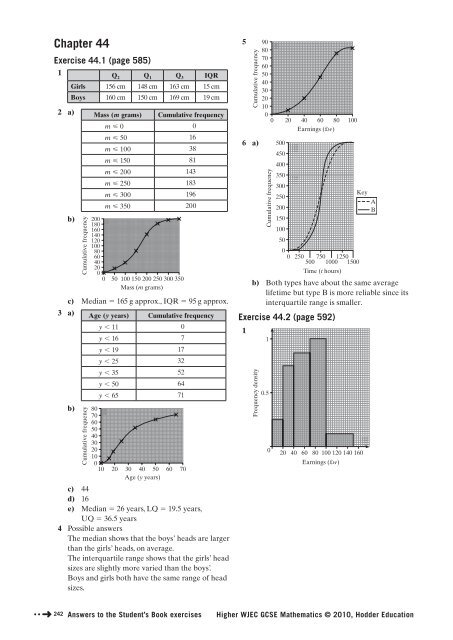AnSWErS to tHE StudEnt'S Book ExErCiSES - Hodder Plus Home
AnSWErS to tHE StudEnt'S Book ExErCiSES - Hodder Plus Home
AnSWErS to tHE StudEnt'S Book ExErCiSES - Hodder Plus Home
You also want an ePaper? Increase the reach of your titles
YUMPU automatically turns print PDFs into web optimized ePapers that Google loves.
Chapter 44Exercise 44.1 (page 585)1 Q 2 Q 1 Q 3 IQRGirls 156 cm 148 cm 163 cm 15 cmBoys 160 cm 150 cm 169 cm 19 cm2 a) Mass (m grams) Cumulative frequencym < 0 0m < 50 16m < 100 38m < 150 81m < 200 143m < 250 183m < 300 196m < 350 200b)Cumulative frequency200180160140120100806040200050100 150 200 250 300 350Mass (m grams)c) Median 5 165 g approx., IQR 5 95 g approx.3 a) Age (y years) Cumulative frequencyb)Cumulative frequency8070605040302010010y , 11 0y , 16 7y , 19 17y , 25 32y , 35 52y , 50 64y , 65 712030 40 50Age (y years)60 70c) 44d) 16e) Median 5 26 years, LQ 5 19.5 years,UQ 5 36.5 years4 Possible answersThe median shows that the boys’ heads are largerthan the girls’ heads, on average.The interquartile range shows that the girls’ headsizes are slightly more varied than the boys’.Boys and girls both have the same range of headsizes.5Cumulative frequency6 a)90807060504030201000Cumulative frequency50045040035030025020015010050200040 60 80Earnings (£w)100Key250500 750 12501000 1500Time (t hours)b) Both types have about the same averagelifetime but type B is more reliable since itsinterquartile range is smaller.Exercise 44.2 (page 592)1Frequency density10.5020 40 60 80 100 120 140 160Earnings (£w)AB242Answers <strong>to</strong> the Student’s <strong>Book</strong> exercisesHigher WJEC GCSE Mathematics © 2010, <strong>Hodder</strong> Education
















